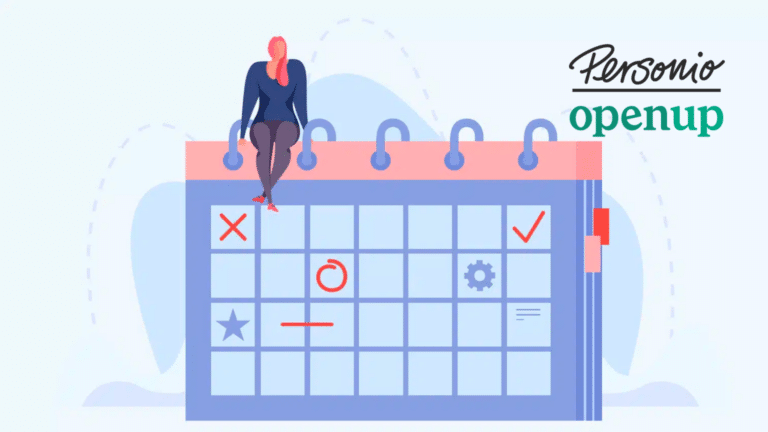Sustainably employed workers are motivated, less likely to call in sick, and stay within an organisation for a long time. This means that, as an employer or HR manager, it is worth devoting time and attention to sustainable employment. We’ll now explain how to do this.
1. Employee Engagement Survey – 2.0
At most organisations, an employee engagement survey is a well-known tool for measuring morale in the workplace on an annual or biannual basis. The classic employee engagement survey has a few drawbacks: With annual or biannual surveys, it’s hard to pick up trends and discrepancies. Insights are often picked up too late to make timely adjustments.
That’s why we advise using the employee engagement survey 2.0. This might look like:
- Daily, weekly, or monthly ask a small number of questions via a web app, that way you can understand what’s going on more quickly and easily;
- Openness and transparency are important assets for successful organisations. Therefore, you should feedback the results – in aggregate form, of course, so that it can’t be traced back to individuals;
- Reward employees for answering the questions. For example, make a scoreboard to keep track of which team has answered the most questions and reward them with an excursion.
While carrying out research, focus on the following things:
- Feeling safe within the workplace
- Feeling healthy overall
- Pleasant and open communication
- The company culture
- Performance in diversity and inclusion
- Ways of working together
- Management performance
- Work-life balance
- The existence of growth- and learning opportunities
- Wether employees are happy at work
- You might want to ask new employees how they feel about the recruitment and onboarding process
TinyPulse, a company that offers an application for measuring employee satisfaction, selects the three questions that get the most responses from within each of these categories. You can download this list here.
Case: Amazon
Each day, Amazon employees get a pop-up in their internal online environment that says: How satisfied are you with your job? Are you valued by your team? Is your manager supporting you enough in your development?
Each team’s answers are compared to the others. Why is one team doing better than another one, and what can we do to improve the situation? Every two months, the results and answers of these questions are discussed with all employees.
2. Make a plan
The survey is step one. Then we can get to work with the results: Creating an improvement plan. Involve as many different departments as possible in this process. Consider HR, the management team, learning and development, diversity managers, team leaders and preferably a randomly selected group of the remaining employees from all corners of the organisation.
Based on the survey results, first outline what the baseline is: How do we currently stand on the topics listed above? Then, collectively determine where you want to go as an organisation and how you are going to get there. For example, use the objectives and key results framework for this. If you want to learn more about this framework, WhatMatters is a good source.
Then distribute the plan of action throughout the organisation. This way you’ll show that you’re taking employee satisfaction seriously and that you’re making adjustments where necessary. For example, during their annual weekend getaway on Schiermonnikoog, Boston Consulting Group speaks to their whole organisation about how satisfied the company is and what they will be working on in the coming year.
3. Encourage life long development
According to Urban Dictionary – the Wikipedia of dictionaries – the definition of a ‘career’ is: “A long period of servitude in exchange for operating capital.” That’s obviously a bit of an overstatement, but the fact is that, for some people, work is nothing more than an exchange of time for money. But ideally, a career is more than that. Specifically, it’s a lifelong opportunity for personal development. This means that sustainable employment is often mentioned in the same breath as lifelong learning.
Most organisations have a learning and development budget for each employee, but often these pots go unused. So, how can you make sure that your employees actually continue to develop throughout their lives? A few tips:
- Get help from an external body to support employees in mapping out their development journey. Consider OpenUp.
- Appoint somebody internal – for example an HR professional or manager – to help employees choose courses and training sessions.
- Demonstrate that using their learning budget is an essential part of an employee’s job responsibilities.
- After asking permission from the respective team members, discuss how all team members are using their learning budget. This will inspire others.
- Offer micro-learning through an app. This allows employees to take accessible classes whenever and wherever they want. You can design the training course yourself, for example through TalentCards or you can make use of pre-existing training courses, for example with apps like Blinkist or Headway, which convey ideas from bestselling non-fiction books.
- Discuss learning objectives and opportunities through check-ins and feedback sessions.
- A strengths-based approach offers a great incentive: Employees focus on developing their strengths, instead of focusing on what they’re less good at.
Lifelong development is about both hard and soft skills. OpenUp is here to help your employees develop their soft skills.
4. Find an alternative role if the current one no longer fits
Employees might outgrow their current role, if for example, they develop as people. Conversely, a role might also outgrow an employee, if for example digital advancements are occurring too quickly for the employee.
An easy way to solve a mismatch between competencies and role is job crafting: Encourage employees to adapt their roles within their current position so that it better suits their needs. For example, if a supermarket employee is having difficulties with the self-checkout system, then allow this employee to work behind the regular cash register. Offering an alternative role within the company could also be a solution: whether it’s a promotion or a relocation.
Needless to say, it’s important that this is always done while consulting the employee. Let employees know about your ideas as soon as possible. The last thing you want is for the person to hear about them through someone else.
5. Offer good (secondary) employment benefits
Young people and low-skilled workers are particularly likely to change jobs quickly and often. This is because they tend to see work as an exchange of time for money, rather than a means of personal development. With a competitive salary and good secondary employment benefits, you can retain staff in this group. But a competitive salary and good secondary employment benefits are actually important at every layer of an organisation if you want to keep people engaged and motivated.
You’ll already be all too familiar with the standard employment benefits: Plenty of vacation days, bonuses, travel allowances, free lunches, and a company phone. So, let us inspire you with a selection of more unorthodox secondary employment benefits from other companies:
- Evernote employees get a travel budget of $1000 when they go on vacation
- Patagonia offers child care at work
- Dropbox has meeting-free Wednesdays for recharging your mental batteries
- Lululemon offers free exercise classes to employees
- Rituals, Adyen and CBRE let their employees use OpenUp psychologists for free
- Asana has a nap room in its offices
- Activision Blizzard employees can make use of onsite masseuses
- At Treehouse, everyone gets Fridays off
- If you work at Timberland, you can spend up to 40 hours a year on voluntary work while still being paid your salary
- Employees at Google get free legal advice, as well as access to a heated swimming pool
6. Offer schemes that keep employees mentally and physically strong
Healthy employees stay employed for longer. That means these kinds of investments end up paying for themselves. Research shows that every euro – or actually dollar, because it was American research – spent on employee health programs, generates a cost saving of 6 times its original amount.
Things that support employee physical health include:
- A safe and ergonomic workplace
- Healthy lunches at work
- Gym equipment at work or a gym subscription
- Health insurance
- Training sessions on healthy eating
- A cycling plan
You can support employee mental health by, for example, offering free access to consultations with an external psychologist. OpenUp can help you with this. In addition, it’s important to normalise conversations about mental health and to keep talking about it with one another. Want to learn more?
Want to learn more about this topic? 👉 Get in touch with us.





